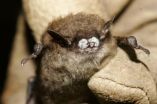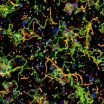(Press-News.org)
Culling will not stop the spread of a deadly fungus that is threatening to wipe out hibernating bats in North America, according to a new mathematical model.
White-nose syndrome, which is estimated to have killed over a million bats in a three year period, is probably caused by a newly discovered cold-adapted fungus, Geomyces destructans. The new model examines how WNS is passed from bat to bat and concludes that culling would not work because of the complexity of bat life history and because the fungal pathogen occurs in the caves and mines where the bats live.
"Because the disease is highly virulent, our model results support the hypothesis that transmission occurs in all contact areas," write the paper's authors, Tom Hallam and Gary McCracken, both of the University of Tennessee. "Our simulations indicated culling will not control WNS in bats primarily because contact rates are high among colonial bats, contact occurs in multiple arenas, and periodic movement between arenas occurs."
Ground work on the model was initiated in a 2009 modeling workshop on white-nose syndrome held at the National Institute for Mathematical and Biological Synthesis (NIMBioS) in Knoxville, Tennessee. At the interdisciplinary workshop, experts in the fields of bat physiology, fungal ecology, ecotoxicology, and epidemiology discussed ways in which mathematical modeling could be applied to predict and control the spread of WNS.
"NIMBioS' support for the workshop that initiated this project was crucial in helping formulate models that could be useful in looking at white-nose syndrome," Hallam said.
Culling of bats in areas where the disease is present is one of several options that have been considered by state and federal agencies as a way to control the disease. However, a review of management options for controlling WNS in the paper indicates that culling is ineffective for disease control in wild animals and in some cases, can exacerbate the spread.
White-nose syndrome first appeared in a cave in upstate New York in 2006, and has since spread to 14 states and as far north as Canada. Regional extinctions of the most common bat species, the little brown bat, are predicted within two decades due to WNS.
Eating up to two-thirds of their body weight in insects every night, bats help suppress insect populations ultimately reducing crop damage and the quantities of insecticides used on crops. Bats also play an important ecological role in plant pollination and seed dissemination.
INFORMATION:
The National Institute for Mathematical and Biological Synthesis (NIMBioS) (http://www.nimbios.org) brings together researchers from around the world to collaborate across disciplinary boundaries to investigate solutions to basic and applied problems in the life sciences. NIMBioS is sponsored by the National Science Foundation, the U.S. Department of Homeland Security, and the U.S. Department of Agriculture with additional support from The University of Tennessee, Knoxville.
Citations: Hallam TG, McCracken GF. 2011. Management of the panzootic white-nose syndrome through culling of bats. Conservation Biology 25(1): 189-194.
Culling can't control deadly bat disease
2011-02-15
ELSE PRESS RELEASES FROM THIS DATE:
NIH study finds 2 pesticides associated with Parkinson's disease
2011-02-15
New research shows a link between use of two pesticides, rotenone and paraquat, and Parkinson's disease. People who used either pesticide developed Parkinson's disease approximately 2.5 times more often than non-users.
The study was a collaborative effort conducted by researchers at the National Institute of Environmental Health Sciences (NIEHS), which is part of the National Institutes of Health, and the Parkinson's Institute and Clinical Center in Sunnyvale, Calif.
"Rotenone directly inhibits the function of the mitochondria, the structure responsible for making ...
Playtime helps bind generations
2011-02-15
This release is available in French.
Montreal, February 14, 2010 – A new study has confirmed an old adage: A family that plays together stays together. Researchers from Concordia University and Wilfrid Laurier University examined the ways grandparents can maintain close ties with their adult grandchildren. True to the old maxim, recreation emerged as the glue sealing intergenerational bonds.
"Leisure is vital in the formation of bonds that last from generation to generation," says lead author Shannon Hebblethwaite, a professor in Concordia University's Department ...
Stem cell transplants help kidney damage
2011-02-15
Tampa, Fla. (Feb. 14, 2011) – Transplanting autologous renal progenitor cells (RPCs), (kidney stem cells derived from self-donors), into rat models with kidney damage from pyelonephritis - a type of urinary infection that has reached the kidney - has been found to improve kidney structure and function.
The study, authored by a research team from the Tehran University of Medical Sciences, is published in the current issue of Cell Medicine [1(3)] and is freely available on-line at: http://www.ingentaconnect.com/content/cog/cm .
"Advancements in stem cell therapies and ...
Researchers working toward automating sedation in intensive care units
2011-02-15
Researchers at the Georgia Institute of Technology and the Northeast Georgia Medical Center are one step closer to their goal of automating the management of sedation in hospital intensive care units (ICUs). They have developed control algorithms that use clinical data to accurately determine a patient's level of sedation and can notify medical staff if there is a change in the level.
"ICU nurses have one of the most task-laden jobs in medicine and typically take care of multiple patients at the same time, so if we can use control system technology to automate the task ...
Quest for designer bacteria uncovers a 'Spy'
2011-02-15
ANN ARBOR, Mich.---Scientists have discovered a molecular assistant called Spy that helps bacteria excel at producing proteins for medical and industrial purposes.
Bacteria are widely used to manufacture proteins used in medicine and industry, but the bugs often bungle the job. Many proteins fall apart and get cut up inside the bacteria before they can be harvested. Others collapse into useless tangles instead of folding properly, as they must in order to function normally.
A research team led by James Bardwell, who is a professor of molecular, cellular and developmental ...
New scholarly paper reveals 100 new species of lichenized fungi
2011-02-15
CHICAGO, IL – In an unprecedented coming-out party, 100 newly discovered species are revealed to the world in a single scholarly paper coordinated by Field Museum scientists.
The 100 organisms are lichens, a type of fungi that form associations with algae and populate environments from arctic tundra to tropical rain forests. And the usual inattention bestowed upon new lichens is one reason for aggregating so many new ones in a single paper in the Feb. 18 issue of the journal Phytotaxa.
It is estimated that about 100,000 fungal species, including 17,500 lichens, have been ...
Choosing your neighbors: MBL scientists see how microbes relate in space
2011-02-15
MBL, WOODS HOLE, MA—Like people in cities, microbes often live in complex communities that contain many different microbial types. Also like us, microbes tend to gravitate to and "hang out" with certain other types in their community, more than with the rest. And sometimes, when opportunities arise, they move to more favorable locations.
But until recently, scientists have not been able to look at a microbial community and distinguish the spatial relationship of more than 2 or 3 kinds of microbes at once.
Now, a microscopy technique developed at the Marine Biological ...
Jewel-toned organic phosphorescent crystals: A new class of light-emitting material
2011-02-15
ANN ARBOR, Mich.---Pure organic compounds that glow in jewel tones could potentially lead to cheaper, more efficient and flexible display screens, among other applications.
University of Michigan researcher Jinsang Kim and his colleagues have developed a new class of material that shines with phosphorescence---a property that has previously been seen only in non-organic compounds or organometallics.
Kim and his colleagues made metal-free organic crystals that are white in visible light and radiate blue, green, yellow and orange when triggered by ultraviolet light. ...
Treating the aging knee as an organ
2011-02-15
DETROIT – The human body is made up of several organs composed of tissues that enable them to perform a particular function. The heart circulates blood; the brain is the micro-neuro center of the body; the lungs bring in oxygen and release carbon dioxide.
The failure of any one of these tissue systems can cause serious health issues, even death. When components of the organ are fixed, typically the organ functions better. For instance, unclogging a blocked artery with a balloon stent improves blood circulation to and from the heart.
Henry Ford Hospital researcher Fred ...
Does social anxiety disorder respond to psychotherapy? Brain study says yes
2011-02-15
When psychotherapy is helping someone get better, what does that change look like in the brain? This was the question a team of Canadian psychological scientists set out to investigate in patients suffering from social anxiety disorder. Their findings are published in Psychological Science, a journal of the Association of Psychological Science.
Social anxiety is a common disorder, marked by overwhelming fears of interacting with others and expectations of being harshly judged. Medication and psychotherapy both help people with the disorder. But research on the neurological ...





